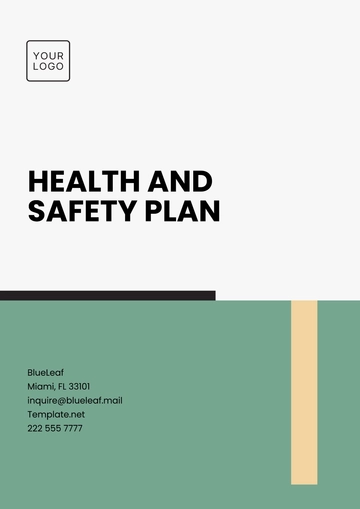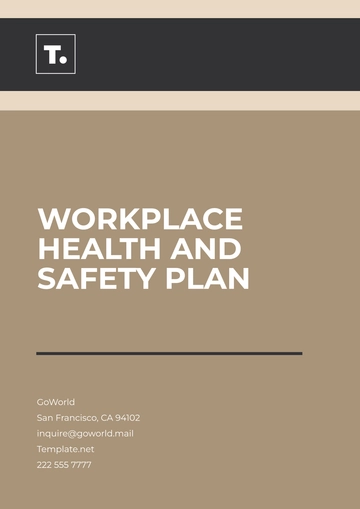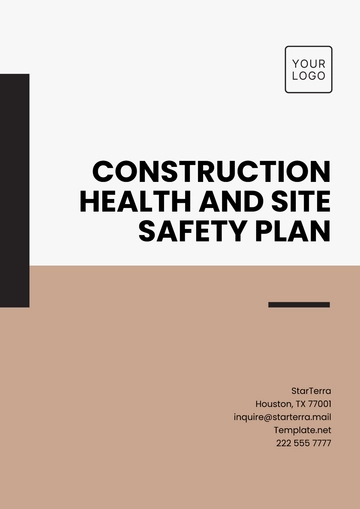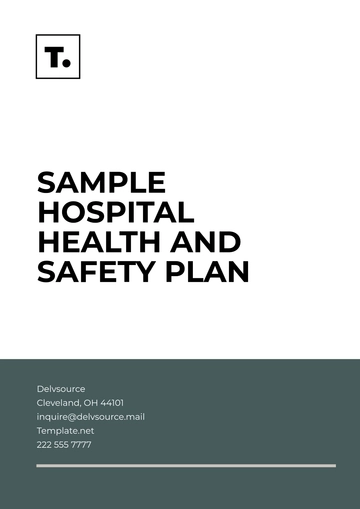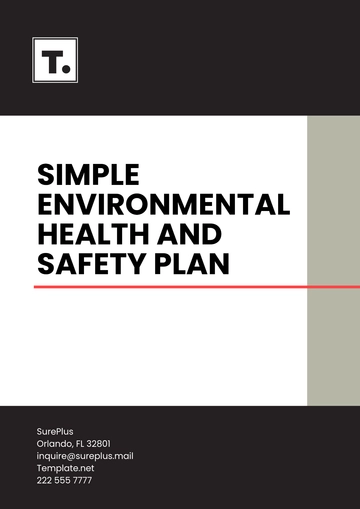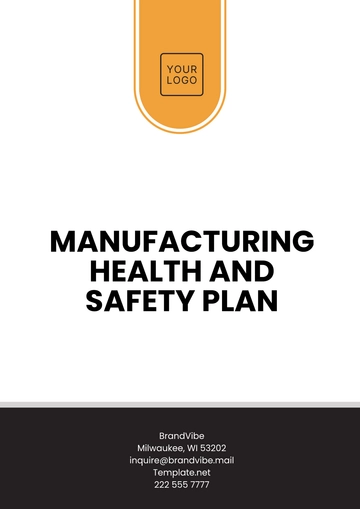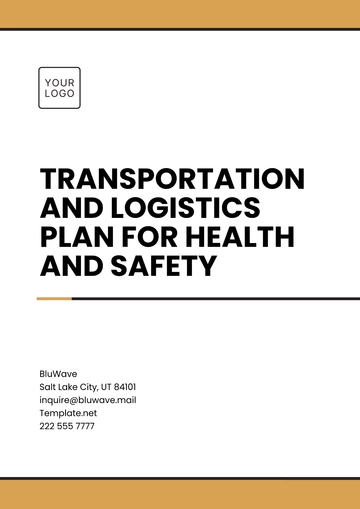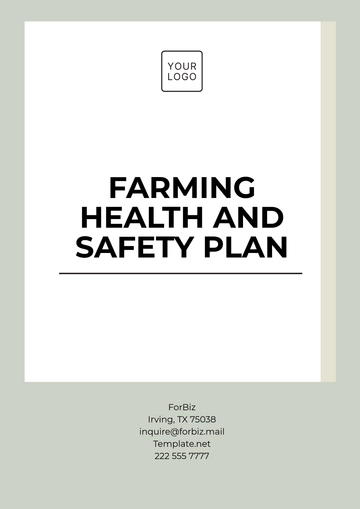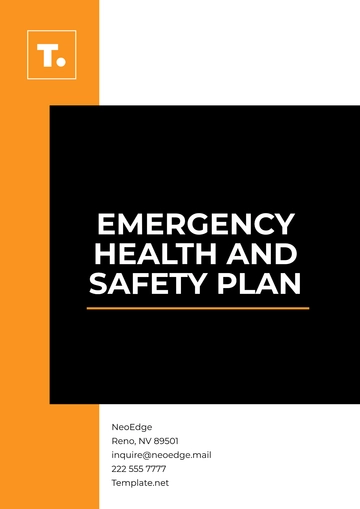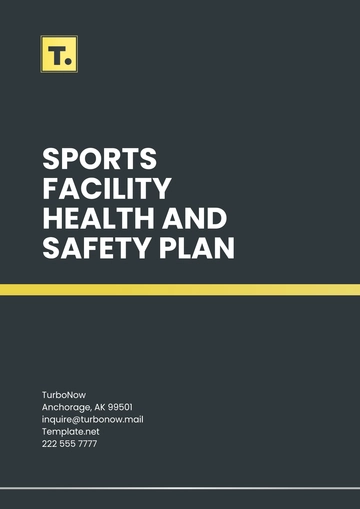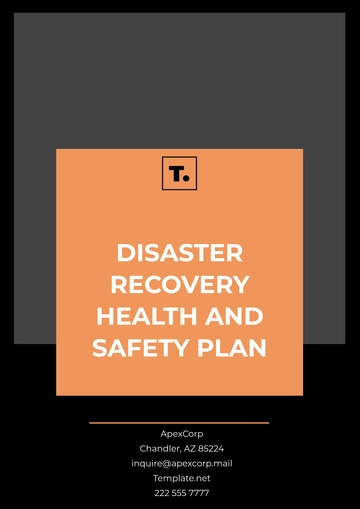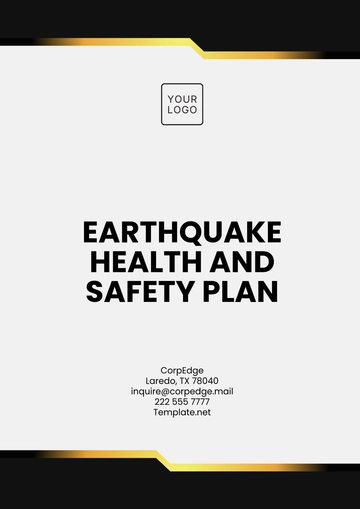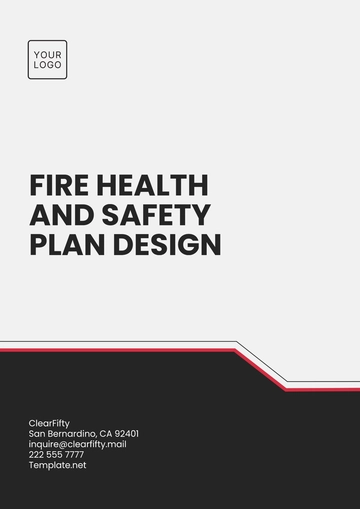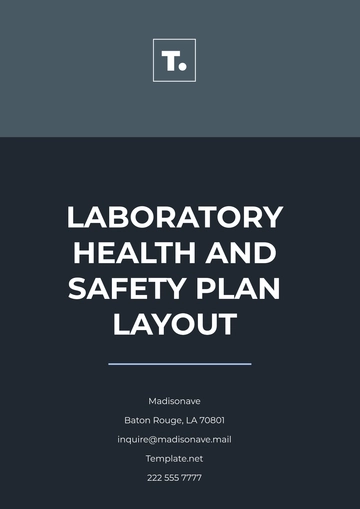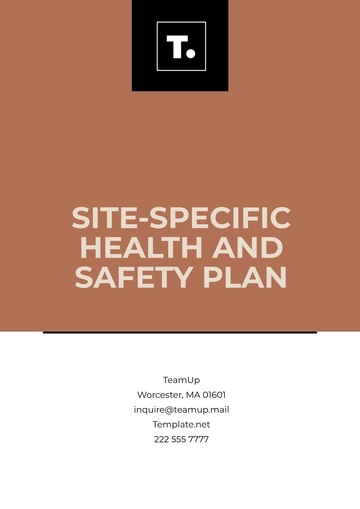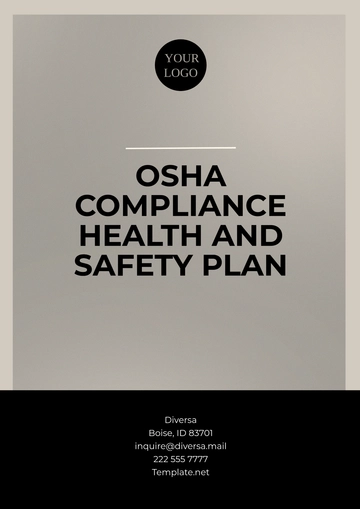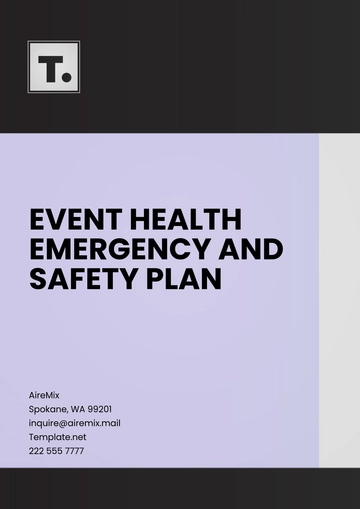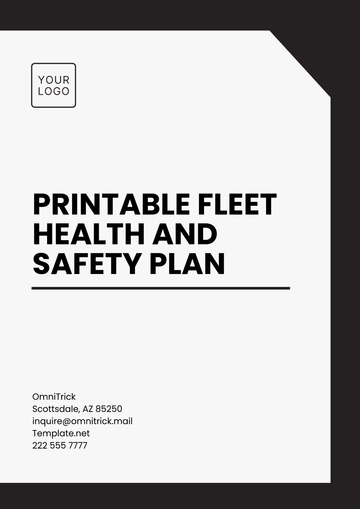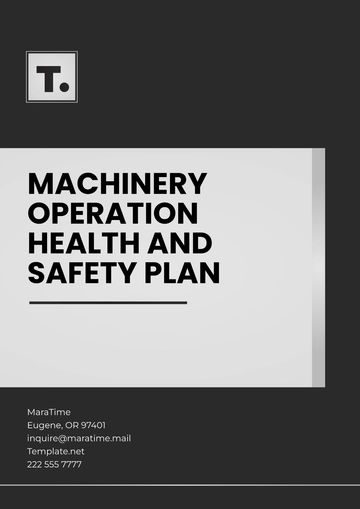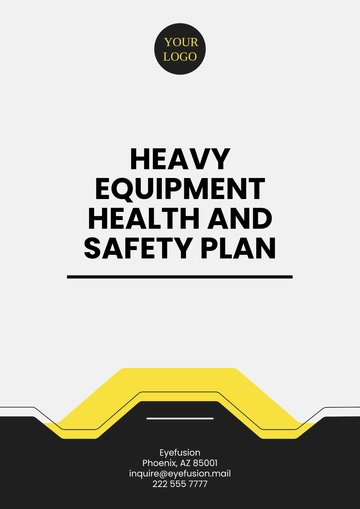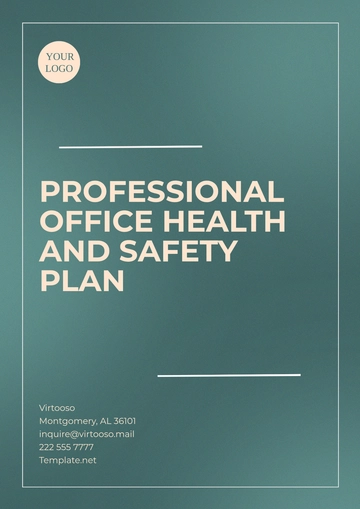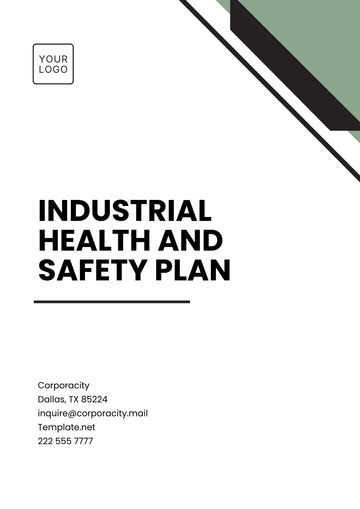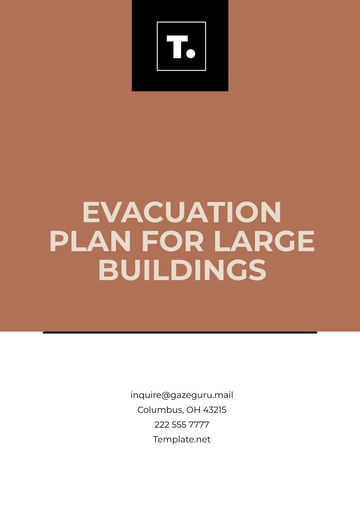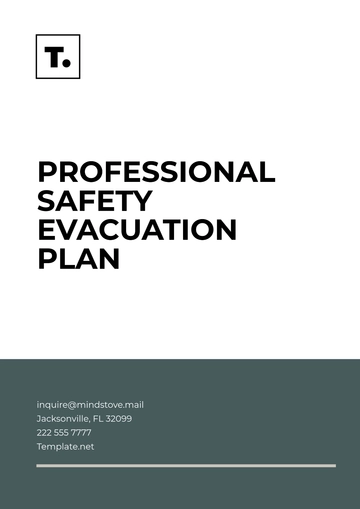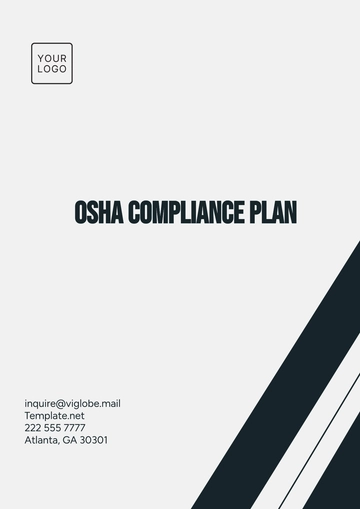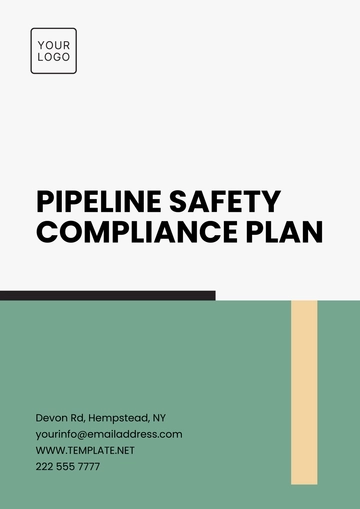Free Heavy Equipment Manufacturing Safety Plan
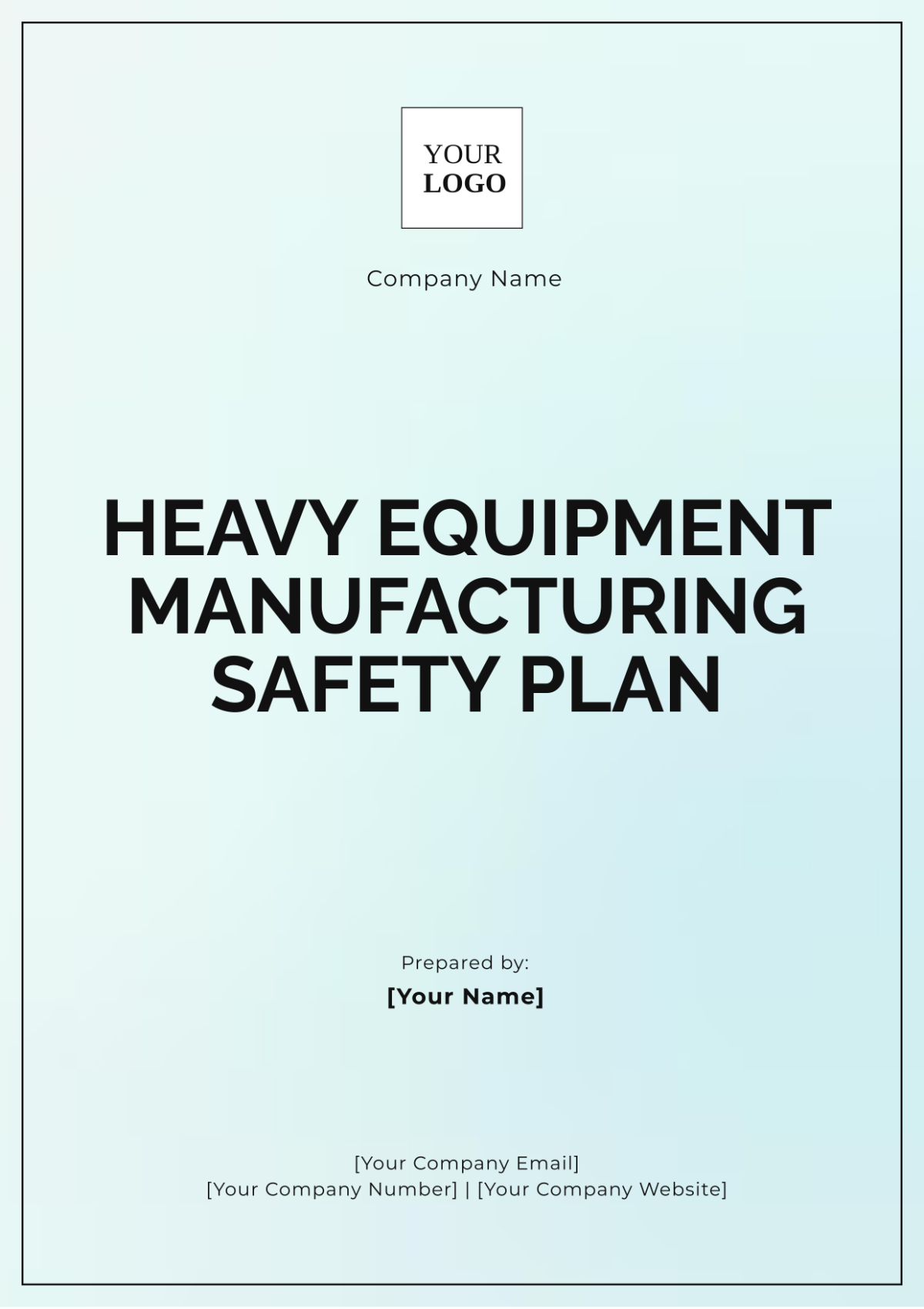
Prepared By: [Your Name]
Company: [Your Company Name]
Date: June 5, 2050
1. Introduction
The Heavy Equipment Manufacturing Safety Plan outlines the measures and protocols necessary to ensure the safety and health of all personnel involved in the manufacturing process. This plan emphasizes adherence to industry standards and regulatory requirements to mitigate risks and promote a safe working environment. By implementing this plan, we aim to foster a culture of safety and continuous improvement.
2. Objectives
The key objectives of this Safety Plan include:
Minimizing workplace accidents and injuries: Implementing effective safety measures to reduce incidents.
Ensuring compliance with occupational safety regulations: Adhering to OSHA regulations and industry standards.
Promoting a culture of safety awareness among employees: Encouraging proactive involvement in safety practices.
Establishing clear procedures for emergencies: Preparing for various emergencies with defined response protocols.
3. Scope
This plan applies to all employees, contractors, and visitors at the manufacturing facility involved in the operation, maintenance, and supervision of heavy equipment.
4. Responsibilities
Management: Ensure implementation and adherence to safety policies, allocate necessary resources for safety training, and support safety initiatives.
Safety Officer: Oversee safety programs, conduct risk assessments, ensure compliance with safety regulations, and lead safety training efforts.
Supervisors: Enforce safety procedures, monitor employee compliance, provide safety training, and report any safety concerns to management.
Employees: Follow safety protocols, participate in training, report any unsafe conditions or practices, and wear required personal protective equipment (PPE).
5. Safety Policies and Procedures
5.1 General Safety Practices
Regular Safety Training and Drills: Conduct monthly safety training sessions and quarterly emergency drills to ensure preparedness.
Personal Protective Equipment (PPE): All employees must wear PPE, including:
Hard hats
Safety glasses
High-visibility clothing
Steel-toed boots
Gloves
Reporting and Addressing Safety Hazards: Implement a hazard reporting system where employees can report unsafe conditions via a designated form or digital platform.
Equipment Maintenance and Inspection: Schedule weekly inspections for all machinery to identify potential issues and perform necessary maintenance.
5.2 Specific Equipment Safety
Forklift and Heavy Machinery Operation: Only trained and certified operators may operate forklifts and heavy machinery. Conduct daily pre-operation checks that include verifying fluid levels, brakes, and safety features.
Power Tools and Welding Equipment: Operators must follow specific usage protocols, including using guards and safety devices, ensuring proper ventilation, and wearing appropriate PPE.
Hazardous Materials Handling and Storage: Store hazardous materials in designated areas with appropriate labeling. Ensure MSDS (Material Safety Data Sheets) are accessible to all employees.
6. Training and Education
6.1 Employee Orientation
All new employees will undergo a comprehensive safety orientation covering:
Overview of safety policies and procedures
Specific safety practices related to their roles
Emergency procedures, including evacuation routes
6.2 Ongoing Training
Schedule quarterly training sessions that cover:
Updates on new safety protocols and equipment
Refresher courses on equipment operation and PPE usage
Workshops on hazard identification and reporting
6.3 Certification and Competency
All employees operating heavy machinery must:
Complete a formal training program approved by the organization.
Obtain certification from recognized training organizations (e.g., OSHA, ANSI).
Demonstrate competency through practical assessments conducted by certified trainers.
7. Emergency Preparedness
7.1 Emergency Response Plan
Develop and communicate an emergency response plan that includes:
Identification of potential emergencies (e.g., fire, equipment failure, chemical spills)
Clearly defined roles and responsibilities during an emergency
Regularly updated contact lists for emergency services and internal responders
Conduct regular emergency drills (at least twice a year) to test the response plan and familiarize employees with evacuation routes and assembly points.
7.2 First Aid and Medical Services
Train at least one employee in basic first aid and CPR in each department.
Ensure that first aid kits are stocked and accessible in all work areas.
Establish a partnership with local medical services for quick response in case of emergencies.
8. Monitoring and Continuous Improvement
8.1 Safety Audits and Inspections
Conduct comprehensive safety audits every six months to identify potential hazards and ensure compliance with safety standards.
Document findings and implement corrective actions as needed.
8.2 Incident Reporting and Analysis
All incidents, no matter how minor, must be reported using the incident report form within 24 hours.
Analyze each incident to identify root causes and develop corrective actions to prevent recurrence.
Maintain a log of incidents and follow-up actions for review.
8.3 Employee Feedback
Encourage employees to provide feedback on safety practices through:
Regular safety meetings
Anonymous suggestion boxes placed around the facility
Surveys to gauge employee perceptions of safety practices
Review feedback during monthly safety committee meetings and implement changes as needed.
9. Conclusion
The Heavy Equipment Manufacturing Safety Plan is a critical component in ensuring the safety and well-being of all employees. By adhering to the outlined procedures and continuously striving for improvement, the organization can create a safe and productive working environment. All personnel are encouraged to actively participate in maintaining safety standards and to report any unsafe conditions immediately.
10. Appendices
Appendix A: Safety Training Schedule
Appendix B: Equipment Inspection Checklist
Appendix C: Emergency Contact List
Appendix D: Incident Report Form
Appendix E: PPE Requirements by Job Role
- 100% Customizable, free editor
- Access 1 Million+ Templates, photo’s & graphics
- Download or share as a template
- Click and replace photos, graphics, text, backgrounds
- Resize, crop, AI write & more
- Access advanced editor
Ensure a safe working environment in heavy equipment manufacturing with the Heavy Equipment Manufacturing Safety Plan Template from Template.net. This editable and customizable template is specifically designed to address the unique safety challenges of the industry. Tailor its content to meet your facility's specific safety protocols and regulatory requirements. With clear guidelines and an organized layout, you can effectively communicate vital safety measures, protecting your workforce and enhancing operational efficiency.
You may also like
- Finance Plan
- Construction Plan
- Sales Plan
- Development Plan
- Career Plan
- Budget Plan
- HR Plan
- Education Plan
- Transition Plan
- Work Plan
- Training Plan
- Communication Plan
- Operation Plan
- Health And Safety Plan
- Strategy Plan
- Professional Development Plan
- Advertising Plan
- Risk Management Plan
- Restaurant Plan
- School Plan
- Nursing Home Patient Care Plan
- Nursing Care Plan
- Plan Event
- Startup Plan
- Social Media Plan
- Staffing Plan
- Annual Plan
- Content Plan
- Payment Plan
- Implementation Plan
- Hotel Plan
- Workout Plan
- Accounting Plan
- Campaign Plan
- Essay Plan
- 30 60 90 Day Plan
- Research Plan
- Recruitment Plan
- 90 Day Plan
- Quarterly Plan
- Emergency Plan
- 5 Year Plan
- Gym Plan
- Personal Plan
- IT and Software Plan
- Treatment Plan
- Real Estate Plan
- Law Firm Plan
- Healthcare Plan
- Improvement Plan
- Media Plan
- 5 Year Business Plan
- Learning Plan
- Marketing Campaign Plan
- Travel Agency Plan
- Cleaning Services Plan
- Interior Design Plan
- Performance Plan
- PR Plan
- Birth Plan
- Life Plan
- SEO Plan
- Disaster Recovery Plan
- Continuity Plan
- Launch Plan
- Legal Plan
- Behavior Plan
- Performance Improvement Plan
- Salon Plan
- Security Plan
- Security Management Plan
- Employee Development Plan
- Quality Plan
- Service Improvement Plan
- Growth Plan
- Incident Response Plan
- Basketball Plan
- Emergency Action Plan
- Product Launch Plan
- Spa Plan
- Employee Training Plan
- Data Analysis Plan
- Employee Action Plan
- Territory Plan
- Audit Plan
- Classroom Plan
- Activity Plan
- Parenting Plan
- Care Plan
- Project Execution Plan
- Exercise Plan
- Internship Plan
- Software Development Plan
- Continuous Improvement Plan
- Leave Plan
- 90 Day Sales Plan
- Advertising Agency Plan
- Employee Transition Plan
- Smart Action Plan
- Workplace Safety Plan
- Behavior Change Plan
- Contingency Plan
- Continuity of Operations Plan
- Health Plan
- Quality Control Plan
- Self Plan
- Sports Development Plan
- Change Management Plan
- Ecommerce Plan
- Personal Financial Plan
- Process Improvement Plan
- 30-60-90 Day Sales Plan
- Crisis Management Plan
- Engagement Plan
- Execution Plan
- Pandemic Plan
- Quality Assurance Plan
- Service Continuity Plan
- Agile Project Plan
- Fundraising Plan
- Job Transition Plan
- Asset Maintenance Plan
- Maintenance Plan
- Software Test Plan
- Staff Training and Development Plan
- 3 Year Plan
- Brand Activation Plan
- Release Plan
- Resource Plan
- Risk Mitigation Plan
- Teacher Plan
- 30 60 90 Day Plan for New Manager
- Food Safety Plan
- Food Truck Plan
- Hiring Plan
- Quality Management Plan
- Wellness Plan
- Behavior Intervention Plan
- Bonus Plan
- Investment Plan
- Maternity Leave Plan
- Pandemic Response Plan
- Succession Planning
- Coaching Plan
- Configuration Management Plan
- Remote Work Plan
- Self Care Plan
- Teaching Plan
- 100-Day Plan
- HACCP Plan
- Student Plan
- Sustainability Plan
- 30 60 90 Day Plan for Interview
- Access Plan
- Site Specific Safety Plan
